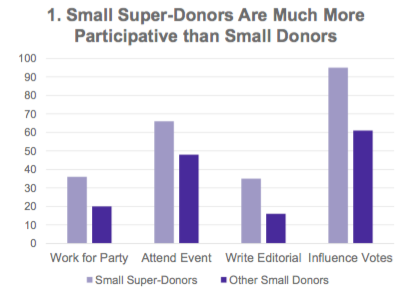Phelps, Dustin
The Rise of the Small Super Donor & the Looming Transformation of Political Influence
Faculty Mentor: Jay Goodliffe, Political Science
Introduction
In light of ongoing controversy over Super PACS, I chose to study how small donors might
offset the disproportionate influence that the wealthy have traditionally maintained in the
American campaign finance system. The dramatic rise of small donors in the 2008, 2012, and
2016 presidential elections heralds a democratic force that could theoretically balance the donor
landscape in unprecedented ways.1 Since small donors are much more representative of the
general population than the traditional wealthy donor, a strong enough presence of small donors
could potentially close America’s political influence gap.2
Within this subset of small donors, I honed in on a special group of small donors that I refer to as
“Small Super-Donors.” These Small Super-Donors are “unitemized” donors (meaning they
contributed less than $200 to a candidate) who actively try to convince others to donate. This
behavior is analogous to the “bundling” behavior of elites where wealthy individuals exploit
their social networks to accumulate checks for a particular candidate.3 I compared these “Small
Super Donors both to other small donors and to “itemized donors” (donors who gave between
$200 and the max-out) in terms of demographics, motivations, and political behavior.
Methodology
I used the BYU 2008 and 2012 dataset of presidential donors to study the attributes of Small
Super-Donors and how they compare to other donors. I performed cross tabulations and probit
analysis on a wide range of related covariates.
Results
I found that Small Super-Donors are not just “super” in the sense that they are donors who
attempt to persuade others to donate. They are also much more likely to engage in just about
every other political participation activity the dataset measures (see figure 1).
Furthermore, I found that the younger the small donor was, the more likely she was to be a Small
Super-Donor—as opposed to just being a mere small donor (see figure 2).
Discussion
If technology and a new social media culture is what causes the higher propensity of young small
donors to engage in “bundling” behavior, then, holding everything else constant, we can expect
the number of small donors to continue growing as the rate of “bundling” among young small
donors begins to permeate the ranks of older small donors (as young small donors age).
Since small super-donors are also much more likely to engage in other participation behaviors,
campaigns may profit from discovering how to activate and energize this type of small donor.
Conclusion
The subset of 2008 small donors, called Small Super Donors, show how the dynamics of the 21st
century may increasingly enable lower income, younger, and minority groups to wield a more
proportionate share of the influence derived from campaign contributions.
Figure 1
Scholarly Sources:
1. Magleby, David B, Jay Goodliffe and Joe Olsen. “Who Donates?”
Unpublished Manuscript, 2015.
2. Ibid
3. Ibid

